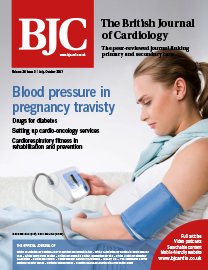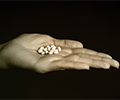2017, Volume 24, Issue 3, pages 81–120

2017, Volume 24, Issue 3, pages 81–120
Editorials Clinical articles News and viewsTopics include:-
- Self-monitoring BP in pregnancy
- The age of diagnostic coronary angiography is over
- NOACs in catheter ablation of AF
- Drugs for diabetes: glitazones
Editorials
Back to topAugust 2017 Br J Cardiol 2017;24:87–8 doi:10.5837/bjc.2017.021
Self-monitoring blood pressure in pregnancy: is this the way forward?
Josephine Walshaw, Richard J McManus

Hypertension is a significant problem, both in the general population and among pregnant women, with around one in 10 women experiencing a form of hypertensive disorder during pregnancy.1 It is the third most common direct cause of maternal mortality worldwide, after haemorrhage and infection,2 and is also associated with adverse affects to the baby, including intrauterine growth retardation, premature delivery and respiratory distress syndrome.3
August 2017 Br J Cardiol 2017;24:90–2 doi:10.5837/bjc.2017.022
Are NOACs safe in catheter ablation of atrial fibrillation?
Adam J Graham, Richard J Schilling

Atrial fibrillation (AF) is known to increase stroke risk and can be stratified clinically by the CHA2DS2-VASc scoring system, which then informs recommendations for long-term anticoagulation. Susceptibility to thromboembolism is also increased around the time of catheter ablation of AF. Mechanistically, this is accounted for by endothelial injury, hypercoagulability due to contact of blood with foreign surfaces and altered blood flow after conversion to normal sinus rhythm (figure 1).1 The risk of stroke persists post-ablation, even in patients with low CHA2DS2-VASc scores, as the atria may remain stunned for several weeks post-ablation, and the endothelium takes time to heal. This phenomenon forms the rationale for guidelines currently recommending anticoagulation for two to three months post-ablation.2
Clinical articles
Back to topAugust 2017 Br J Cardiol 2017;24:117 doi:10.5837/bjc.2017.023
Brugada syndrome in the context of a fever: a case study and review of current knowledge
Saad Ahmad, Irfan Ahmed

Brugada syndrome is a distinct arrhythmogenic disorder widely recognised as a sudden cause of death in the young. It is identified by a classical ST-segment elevation on electrocardiogram (ECG) that may be provoked in the context of a fever or vagal stimulation. The pathophysiology and genetic basis have been elucidated as an abnormality in ion channels. Diagnosis takes into account, not only the ECG, but clinical features and modulating factors; the inducibility of a suspect ECG when febrile is one such observation. Anti-arrhythmic drugs like ajmaline can also induce Brugada syndrome and have a role in its work-up. Electrophysiology studies may be useful in assessment and risk stratification of select cases. The management is centred around device therapy with the implantable cardioverter defibrillator (ICD), though pharmacological treatments are being actively pursued.
August 2017 Br J Cardiol 2017;24:120 doi:10.5837/bjc.2017.024
Multiple left atrial masses in a patient with breast cancer
Debjit Chatterjee

This is a rare case with dramatic image of multiple clot formation in the left atrium in a patient with mitral stenosis when anticoagulation was stopped for a few days before cancer surgery.
July 2017 Br J Cardiol 2017;24:105–7 doi:http://doi.org/10.5837/bjc.2017.017
The age of diagnostic coronary angiography is over
Andrew J M Lewis

This article won first prize in the recent British Junior Cardiologists’ Association (BJCA) essay competition.
Coronary angiography stubbornly bucks the hospital-wide trend to non-invasive diagnostic tests. New imaging technologies offer paths to better ways to investigate and manage ischaemic heart disease.
July 2017 Br J Cardiol 2017;24:100–4 doi:http://doi.org/10.5837/bjc.2017.020
Randomised clinical trial comparing transradial catheterisation with or without prophylactic nitroglycerin
Roberto Léo da Silva, Luis Sérgio Carvalho Luciano, Daniel Medeiros Moreira, Tammuz Fattah, Ana Paula Trombetta, Luciano Panata, Leandro Waldrich, Luiz Eduardo Koenig São Thiago, Luiz Carlos Giuliano

Spasm after transradial approach for catheterisation decreases procedural success and offers discomfort to the patient. Nitroglycerin is one of the drugs applied prophylactically to prevent spasm. The aim of this study was to assess the effect of preventive nitroglycerin on the comfort of patients during cardiac catheterisation.
A total of 328 patients were randomly assigned to receive either 200 µg nitroglycerin (n=164) or placebo (n=164). The main outcome was the evaluation of spasm using a visual analogue scale to measure the pain of the patient, and procedural time and radiation used to measure the operator difficulty during the examination.
The pain evaluation was equal in both groups (nitroglycerin 24.74 vs. placebo 24.75, p=0.72). Using the operator’s impression, there was a higher incidence of spasm in the placebo group (9.1% grade 3 or 4 vs. 2.4% in the nitroglycerin group, p=0.004), while procedural time (21.36 minutes vs. 22.24 minutes, p=0.23) and radiation exposure (655.61 mGy vs. 660.92 mGy, p=0.63) were comparable in both arms.
In conclusion, the prophylactic use of nitroglycerin offers no advantage in terms of comfort to the patient during cardiac catheterisation by a transradial approach. Although there was difference in operators’ perception of spasm, omission of vasodilator does not cause any objective difficulty to operators.
July 2017 Br J Cardiol 2017;24:108–12 doi:http://doi.org/10.5837/bjc.2017.019
A review of endomyocardial biopsy and current practice in England: out of date or underutilised?
Alex Asher

Endomyocardial biopsy (EMB) has been long established as a diagnostic tool in myocardial disease. EMB surveillance for rejection of cardiac allografts continues to be routinely performed. However, the use of EMB beyond transplant monitoring is controversial. In recent years, the procedure has fallen out of favour. This is most likely due to the growing capabilities of non-invasive imaging modalities and the questionable impact of EMB findings on treatment.
This article aims to examine current practice of EMB in England, discuss the utility of EMB in myocardial diseases and compare prominent society guidelines from recent years. Information gained from freedom of information requests shows just 18% of NHS trusts reported performing EMB, and only 46% referred to other centres for EMB in England in 2014–2015. Despite the limitations of EMB, it remains the only procedure capable of obtaining a histological diagnosis of cardiac disease.

July 2017 Br J Cardiol 2017;24:113–16 doi:http://doi.org/10.5837/bjc.2017.018
Glitazones (thiazolidinediones)
Emma Johns, Gerry McKay, Miles Fisher

Glitazones improve glycaemic control in type 2 diabetes mellitus (T2DM) by increasing whole-body insulin sensitivity. They can cause fluid retention and are, therefore, contraindicated in heart failure. A 2007 meta-analysis linked rosiglitazone with an increased risk of myocardial infarction, leading to its European marketing authorisation being suspended in 2010. Pioglitazone has demonstrated cardiovascular safety for atherosclerotic events in a large, randomised, placebo-controlled trial. A 2016 study in patients with insulin resistance and recent cerebrovascular event showed pioglitazone was associated with reduced risk of further stroke or transient ischaemic attack when compared with placebo, as well as reduced diabetes incidence.
July 2017 Br J Cardiol 2017;24:118–9 doi:http://doi.org/10.5837/bjc.2017.016
Hypertrophic cardiomyopathy and coronary fistulae
Deidre F Waterhouse, Theodore M Murphy, Charles McCreery, Rory O’Hanlon

A sixty-two-year-old asymptomatic man presented for a routine insurance medical. He had no previous cardiac history, nor any significant cardiac risk factors. His examination was normal. His electrocardiogram (ECG), however, was noted to be significantly abnormal, with deep anterior T-wave inversion in the precordial leads (figure 1). Given this abnormality and the potential differential diagnoses, a cardiovascular magnetic resonance (CMR) (Siemens Aera 1.5 T) with regadenosine stress perfusion was performed and images analysed using CMR 42 software (Circle CVI, Calgary).
News and views
Back to topAugust 2017 Br J Cardiol 2017;24:95–6
General news
National audit shows improved heart failure...August 2017 Br J Cardiol 2017;24:97
In brief
‘Biological bypass’ shows promise in coronary artery...August 2017 Br J Cardiol 2017;24:98–9
Correspondence
Pitfalls in the interpretation of cardiopulmonary exercise testing data Dear Sirs Cardiopulmonary exercise testing (CPET) is non-invasive, safe,1 and reproducible.2 CPETs provide objective...August 2017 Br J Cardiol 2017;24:(3)
